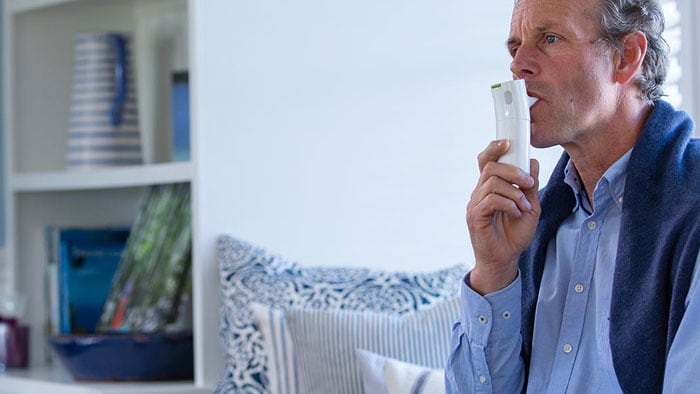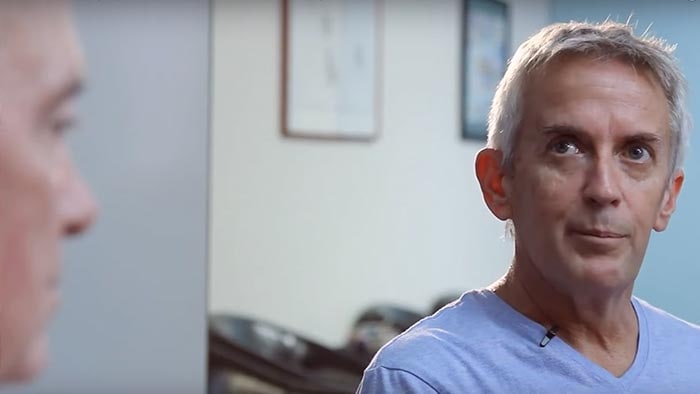Find COVID-19 information specific to our Sleep and Respiratory Care solutions
Managing and treating your COPD
With COPD, how you are feeling can change over the course of a day and over years as your condition progresses. Whether monitoring your air flow to prevent flare-ups or supplementing your oxygen supply, our therapeutic devices support you in each stage of your condition. Many provide the same technology and performance you would find in a hospital, but are designed to be light, portable and fit your lifestyle.
Mark Junge is a bike adventurer and has COPD. Hear his perspective on how portable oxygen treatment can help others with COPD stay active and empowered.
More information on COPD
-
![Managing your COPD]()
Managing your COPD
Click here to learn more -
![Understanding the stages of COPD]()
Understanding the stages of COPD
Click here to learn more
What are the symptoms of COPD?
COPD athlete Russell Winwood and his physician Dr. Wayne Kelly discuss what it feels like to live with COPD
Solutions for COPD therapy, treatment and daily management
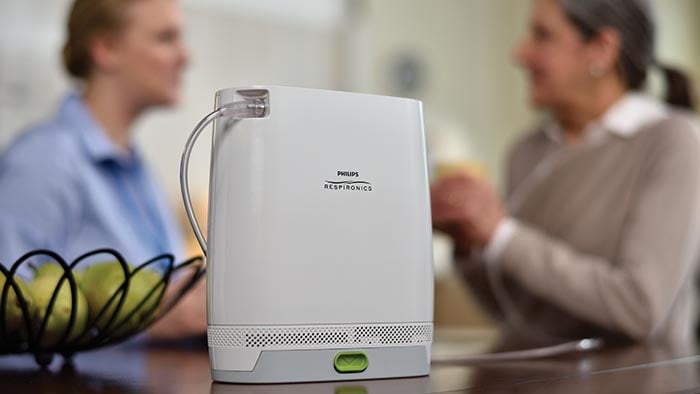
Oxygen (O2) therapy
If during the regular monitoring of your COPD your doctor decides that the oxygen levels in your blood stream are too low, he or she may prescribe oxygen therapy. This may seem quite frightening at first and you may worry about being connected to an oxygen tank. However, oxygen can reduce shortness of breath, allow you to exercise longer and harder, sleep better and generally make you feel better1. Portable oxygen concentrators (POC) like SimplyGo Mini can help you get the oxygen therapy you need inside or outside the house, including when you travel.
Nebulizer and compressor systems
If you have been prescribed liquid medication for inhalation, nebulizers are used to change the liquid into a fine mist which allows it to reach deep into the lungs where it can be most effective. Vibrating mesh nebulizers pull the drug through the microscopic holes in the mesh, which creates the aerosol. Mesh nebulizers are highly efficient and can be used to nebulize most commonly prescribed medications. Fast, effective and easy to use, the Philips InnoSpire Go portable mesh nebulizer is designed to shorten asthma treatment time by 25%2 with virtually silent delivery of medication.
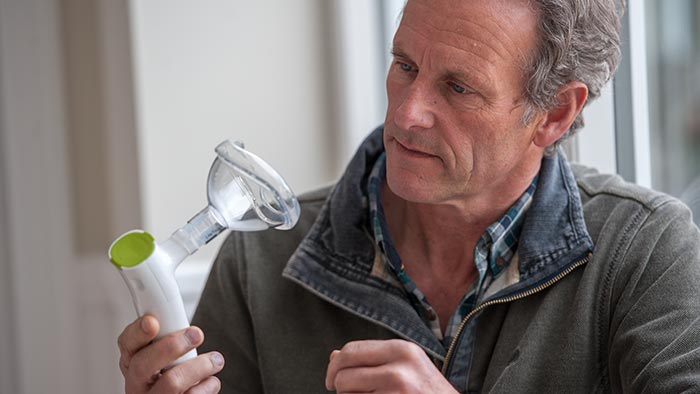
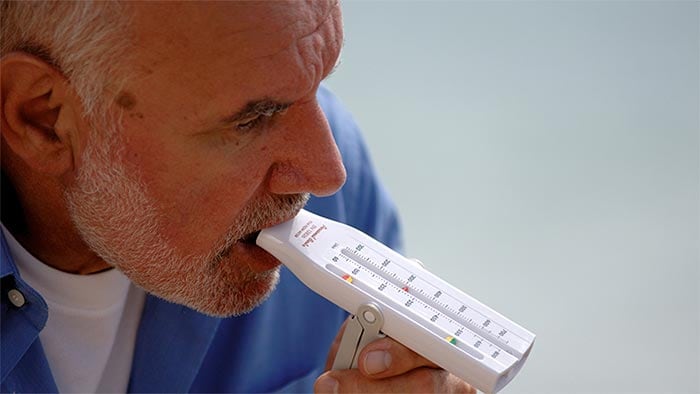
Peak flow meters
A peak flow meter is an inexpensive, portable, handheld device for people with COPD that is used to measure how well air moves out of your lungs. Measuring your peak flow using this meter is an important part of managing your COPD symptoms and to help prevent a flare-up. Lightweight, self-contained and portable, PersonalBest puts peak flow monitoring at your fingertips whenever you need it.
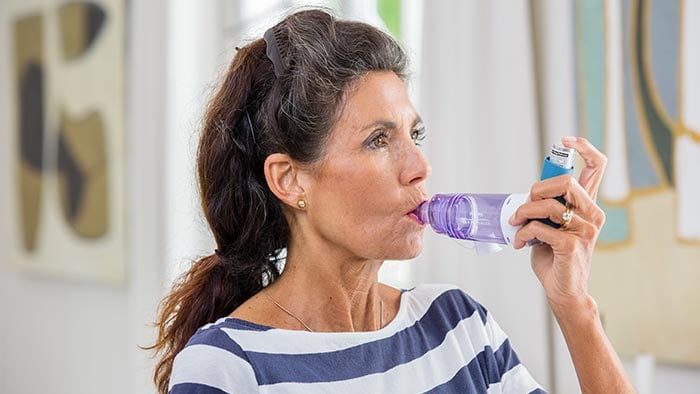
Valved holding chamber and spacers
Spacers and valved holding chambers are used with your inhaler, puffer or pMDI to help deliver medication to your lungs where it is needed. A valved holding chamber may improve drug delivery to the lungs where it is needed by as much as up to four times3. Philips’ OptiChamber Diamond Valved Holding Chamber is discreet, portable and small enough to carry with you.
Tips and inspiration:
Ideas and insights about living with COPD, empowering you to live life to the fullest while managing your condition.
Frequently asked questions
- What is COPD?
-
COPD is a term that covers a number of progressive lung conditions that make breathing difficult, including chronic bronchitis and emphysema¹. One of the main causes is prolonged exposure to cigarette smoke, especially if the smoke is inhaled. However, breathing in second hand smoke, air pollution, chemical fumes and dust from the environment or workplace can also cause COPD².
1. Web MD. What is chronic obstructive pulmonary disease (COPD)?
www.webmd.com/lung/copd/tc/chronic-obstructive-pulmonary-disease-copd-overview
Accessed on 4 August 20152. Web MD. 10 FAQs About Living With COPDWhat is chronic obstructive pulmonary disease (COPD)?
www.webmd.com/lung/copd/10-faqs-about-living-with-copd#2
Accessed on 5 August 2015 - What are the symptoms of COPD?
-
A chronic cough, one that lasts for several weeks without the presence of other illness such as cold or flu, is the first sign of COPD. The cough is usually worse early in the morning, and may be aggravated by exercise or smoke. Other typical symptoms include shortness of breath, wheezing, tightness in the chest and increased mucus (or phlegm) production 1,2.
1. Healthline. Six signs of COPD.
www.healthline.com/health-slideshow/copd-symptoms#9
Accessed on 24 June 2015.2. European Lung Foundation. Lung Factsheet: Living well with COPD.
www.european-lung-foundation.org
Accessed on 19 June 2015. - What causes COPD?
-
One of the main causes of COPD is prolonged exposure to cigarette smoke, especially if the smoke is inhaled. But breathing in secondhand smoke, air pollution, chemical fumes or dust from the workplace also can cause the condition1.
These inhaled particles can cause the mucus glands that line the bronchi to produce more mucus than normal. In addition, the inflammation that they trigger causes the walls of the bronchi to thicken and swell. Environmental factors and genetics may also play a part in the development of COPD 1,2.1. Web MD. 10 FAQs About Living With COPDWhat is chronic obstructive pulmonary disease (COPD)?
www.webmd.com/lung/copd/10-faqs-about-living-with-copd#2
Accessed on 5 August 20152. medicinenet.com. Chronic Bronchitis
www.medicinenet.com/chronic_bronchitis/page3.htmAccessed on 5 August 2015.
- How is COPD treated?
-
Although there is no cure for COPD, there are many effective treatments available to help you manage your symptoms and slow the progression of COPD, so that you can live an active life1.
1. Healthline. COPD and You: Managing Your Symptoms.
www.healthline.com/health/copd/and-you-symptom-management#1Accessed on 10 July 2015.
- How will my illness progress?
-
COPD has four stages, each one with different symptoms of increasing severity. However, by monitoring your symptoms and effectively managing them, it is possible to slow the progression of the disease and to enjoy a more active life1,2.
1. Healthline. COPD and You: Managing Your Symptoms.
www.healthline.com/health/copd/and-you-symptom-management#1Accessed on 10 July 2015.
2. Healthline. COPD: Symptoms and Stages.
www.healthline.com/health/copd/stages#Overview1Access on 6 June 2015.
- What is pulmonary rehab?
-
Combining a program of exercise, education and support, pulmonary rehab can help you live more comfortably with COPD by increasing your capacity for exercise and improving your mobility. You’ll learn about effective breathing techniques, relaxation exercises, the use of medication and oxygen, good nutrition and travel tips, as well as how to avoid flare-ups and stay healthy. Pulmonary rehab also provides an opportunity meet others with COPD to exchange experiences, provide mutual encouragement and increase determination to improve fitness levels and fight the disease1.
1. American Association of Cardiovascular and Pulmonary Rehabilitation (AACVPR). Pulmonary Rehabilitation.
www.copdfoundation.org/Portals/0/Files/pdfs/AACVPR-FactSheet.pdf
Accessed on 6 June 2015. - Is COPD hereditary?
-
Genetics can play a part in the development of COPD, even if you have never smoked or been exposed to pollutants for an extended period of time. In particular, emphysema can be triggered by a deficiency in alpha-1 antitrypsin (AAT), which is a protein that protects the lungs from the harmful effects of white blood cells in the lungs. However, not everyone with COPD who has never smoked has a deficiency on AAT, so it is believed that there must be other genetic triggers for COPD1.
1. COPD Foundation:
www.copdfoundation.org/What-is-COPD/Understanding-COPD/What-is-COPD.aspx#sthash.PjPozNK3.dpufAccessed on 23 June 2015.
- Are there actions I can take to manage my COPD?
-
There are a number of things you can do that will greatly help you to manage your COPD1,2.
- Stop smoking
- Take regular exercise
- Eat well and maintain a healthy weight
- Practice breathing and relaxation techniques
- Learn how to cough effectively
- Recognize and avoid the factors that trigger flare-ups
- Have an action plan for flare-ups
- Take your medications as prescribed
- See your doctor regularly, even if you feel well, and especially if you have any concerns
- Find out if you qualify for pulmonary rehabilitation

Have a product question? We’re here to help

Are you a respiratory health professional?
Did you have a good experience with a Philips product? Help others like you.
References
1 COPD Foundation. Slim Skinny Reference Guide. Oxygen Therapy. 2 Versus predecessor Aeroneb Go. 3 Gardenhire D., Arzu A., Dean H., Myers T. A guide to aerosol delivery devices for respiratory therapists 3rd edition, American Association for Respiratory Care, 2013.

